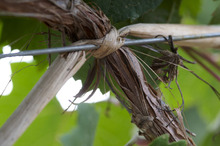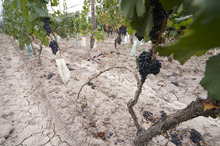Tending the land
Vineyard-keeping is a full-time job.
All viticulture is done with organic practices, and our vineyard received certification in 2015.
Even though the Versado vineyard is less than three hectares (about seven acres), we have an Encargado living on the property to ensure perfect care. Carlos Gómez joined us in 2019 and, along with his wife Carolina Figueroa and their young family, live on-site. As full-time "vineyard keeper," Carlos manually perform the critical daily work in the vineyard. During short seasonal periods when the family alone cannot keep up, Carlos oversees a small team of experienced Mendoza vineyard workers.
 Under the expert viticultural direction of Vineyard Manager, Sergio Rinaldi, the estate is meticulously tended to ensure only the highest quality grapes for classically styled winemaking.
Under the expert viticultural direction of Vineyard Manager, Sergio Rinaldi, the estate is meticulously tended to ensure only the highest quality grapes for classically styled winemaking.
Each of our vines is 100% European. Like the legendary ‘pre-phylloxera vines’ planted in mid-1800’s Europe, all of Versado’s vines are grown “ungrafted.” Entirely on their own roots, not grafted to the phylloxera-resistant rootstocks of native North American grapes, our ancient Malbec vines potentially provide the purest expression of the classic grape variety. Slightly extended growing seasons and naturally reduced quantities of grapes (both enhancing potential flavours) are the other benefits of ungrafted vines. Ancient, ungrafted, noble vinifera varieties are incredibly rare, even in the upper echelons of fine winemaking.
Rebirth.
 As with all living things, a small percent of our vines will die annually. When this happens, rather than replace them with new, grafted clones from a nursery, as is the international norm, we use a method called “layering” to replace them. We leave a long shoot (branch) on a neighbouring ancient vine during pruning, and bend it down into a hole in the ground, turning it straight up again in the location the replacement vine is needed. (Click on the image at right to get a close-up view.)
As with all living things, a small percent of our vines will die annually. When this happens, rather than replace them with new, grafted clones from a nursery, as is the international norm, we use a method called “layering” to replace them. We leave a long shoot (branch) on a neighbouring ancient vine during pruning, and bend it down into a hole in the ground, turning it straight up again in the location the replacement vine is needed. (Click on the image at right to get a close-up view.)
The U-shaped portion that is buried will form roots - miraculously more quickly than a new vine would because of the tremendous energy from the fully established old “mother vine.” Multiplying the effect, a thin steel “girdle” on the buried shoot prevents the flow of any nutrient back to the mother vine, while flow in the other direction is completely unrestricted. The result is a replacement vine that very quickly matures to the qualitative equal of the rest of the ancient vineyard, displaying consistent flavour profiles and, like the mother, 100% ungrafted vinifera. The quick establishment of this vine is especially important in a great, high quality/extremely low vigour vineyard, where a young nursery vine might take as many as eight to ten years to reach its full production, with the grapes still not being of comparable quality.
